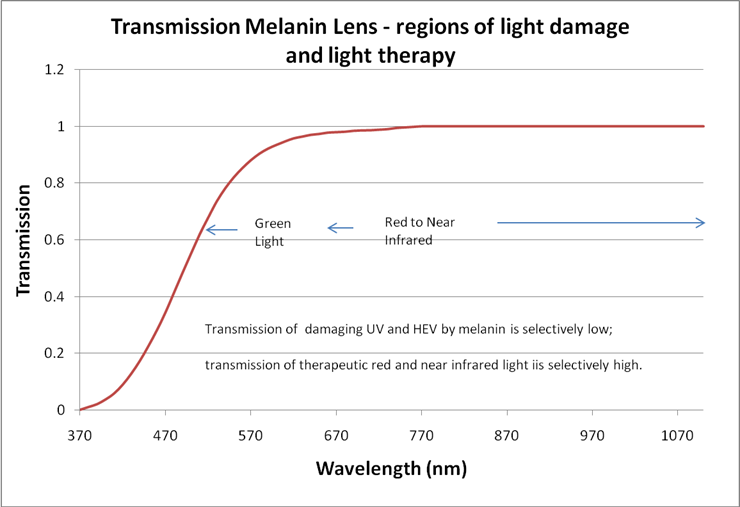In a few words – UV and HEV light are bad; NIR (near infrared) and red light are good.
Melanin lenses progressively filter UV and HEV – but they transmit red and NIR.
But there’s a little more to it than that –
Red Light Phototherapy for the Skin
We don’t give it much thought, but our skin is damaged throughout the day; it’s also being repaired at the same time. Recent tests indicate that the repair rate for skin is: retarded while exposed to blue light; does not change for green light; and actually increases under exposure to red light. In other words, exposure to red light can be therapeutic.
Vision Therapy – from Sunlight
Is red light and near infrared (NIR) therapeutic to the eye? Is it even possible? The answer to these questions is, “Yes.” The lens and vitreous humor (the ultra-clear, jelly-like material that fills the cavity of the eye) transmit the red and NIR light; that is the vitreous humor transmits light between 700 nm and 1400 nm. Furthermore, sunlight has a significant amount of energy between 700 nm and 2300 nm. This is not enough for the indirect sunlight in the 700nm to 1400 nm range to cause thermal damage to the eye, but enough to potentially offer a therapeutic effect. But is there evidence for any therapeutic effect from NIR on vision? The answer again is, “Yes.” (see the References below) So red and NIR light from sunlight can reach the retina and offer constant therapy – provided that our eye wear uses lenses that transmit this therapeutic light.
Melanin Provides Phototherapy to the Eyes
Melanin filters the blue light strongly; it filters the green moderately; and it strongly transmits the red and near infrared (See the Figure below).

Apart from protecting the skin around the eye from wrinkles caused by UV and HEV (high energy visible – violet and blue) light, a melanin lens is therapeutic to the eye and to the skin around the eye due to its selective transmission of red and NIR light.
Red Light Therapy Lenses?
This is a bold new idea for lenses – let alone a new way to think about the sun – that Photoprotective Technologies is proposing (US Patents Pending – 2010). But the concept is supported by decades of science. Here is a short summary of the data:
- UV exposure from sunlight increases glare (1) and the risks of cataracts ( 2) and skin damage (3);
- HEV exposure from sunlight increases the risks of glare (1) and blindness from macular degeneration (4);
- HEV exposure from sunlight increases the risk of skin damage (5);
- Red and Near Infrared light is therapeutic to the skin (6)
- Red and Near Infrared light is therapeutic to the eyes (7,8)
References
(1) J. Zuclich, “Veiling glare: the visual consequences of near-UV/blue light induced fluorescence in the human lens,” Ophthalmic Technologies XV. Edited by Manns, Fabrice; Soederberg, Per G.; Ho, Arthur; Stuck, Bruce E.; Belkin, Michael. Proceedings of the SPIE, Volume 5688, pp. 440-447 (2005).
(2) S. Zigman, Sunlight and human cataracts, Invest. Opthalmol. Visual Sci., 18(5), pp. 462-467 (1979)
(3) UV-induced skin damage, M. Ichihashi et. al., Toxicology, 189, (1-2) pp, 21-39 (2003)
(4) Sunlight exposure, antioxidants, and age-related macular degeneration. Fletcher AE, Bentham GC, Agnew M, Young IS, Augood C, Chakravarthy U, de Jong PT, Rahu M, Seland J, Soubrane G, Tomazzoli L, Topouzis F, Vingerling JR, Vioque J. Arch Ophthalmol., 126(10):1396-403 (2008)
(5) B. Mahmoud et. al., Effects of Visible Light on the Skin, Photochemistry and Photobiology, 84: 450-462 (2008).
(6) M Denda and S Fuziwara, “Visible Radiation Affects Epidermal Permeability Barrier Recovery: Selective Effects of Red and Blue Light,” Journal of Investigative Dermatology (2008) 128, 1335–1336;
(7) Julio C. Rojas,1 Jung Lee,1 Joseph M. John,1 and F. Gonzalez-Lima1,2,3, Neuroprotective Effects of Near-Infrared Light in an In Vivo Model of Mitochondrial Optic Neuropathy. The Journal of Neuroscience, 28(50):13511-13521,(2008).
(8) JE Roberts, pp. 211-224, Effects of Visible Light and Near Infrared in Humans, in “Biophysiological Effects of Solar Radiation on Human Skin,” ed. Paolo Giacomoni Royal Society of Chemistry, Cambridge (2007) .
